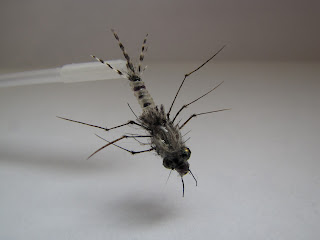 |
| Size #20 Micro-Jelly caddis compare to a Canadian dime. |
 |
| Size #20 Micro-Jelly caddis larvae |
Materials needed for this pattern.
- Hook- scud hook size 12 to 22 or smaller.
- Thread- Uni 8/0 in different colours
- Ribbing- 0.5 mm clear stretch or D-rib
- Thorax- rabbit dubbing, peacock herl or ice dub.
- Legs- partridge, mottle hen, mallard or any hackle fibres. (optional)
1. Place scud hook of choice in the vise and start thread behind hook eye, continue thread in touching to just past hook bend.
2. Tie in a piece of 0.5 mm clear stretch cord about 4 or 5 inches long for easier handling, continue thread back to the thorax area in touching turns for a smother body, about 2 to 3 mm behind hook eye.
3. Start ribbing the body in touching turns, tight at first and begin to loosen up the clear stretch slowly to make a somewhat taper body, tie off clear stretch at thorax area around 2 or 3 mm behind hook eye.
4. Now is a good time to add some legs with a few hackle, partridge or mottle hen fibres.( optional)
5. Tie in 2 peacock herl to finish the thorax area or dub some rabbit dubbing or ice dub to the thread and dub the thorax. Whip finish and add a drop of head cement to complete the fly.!













